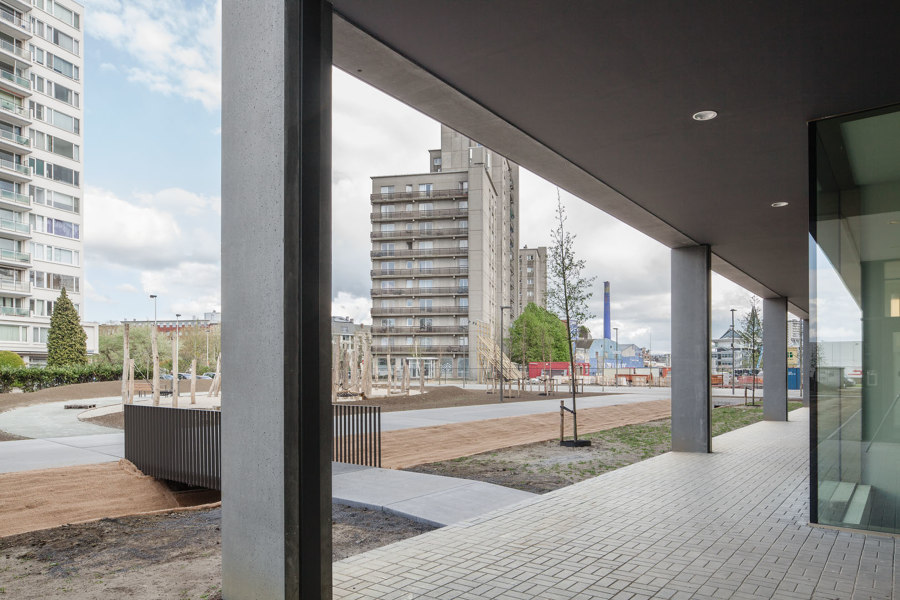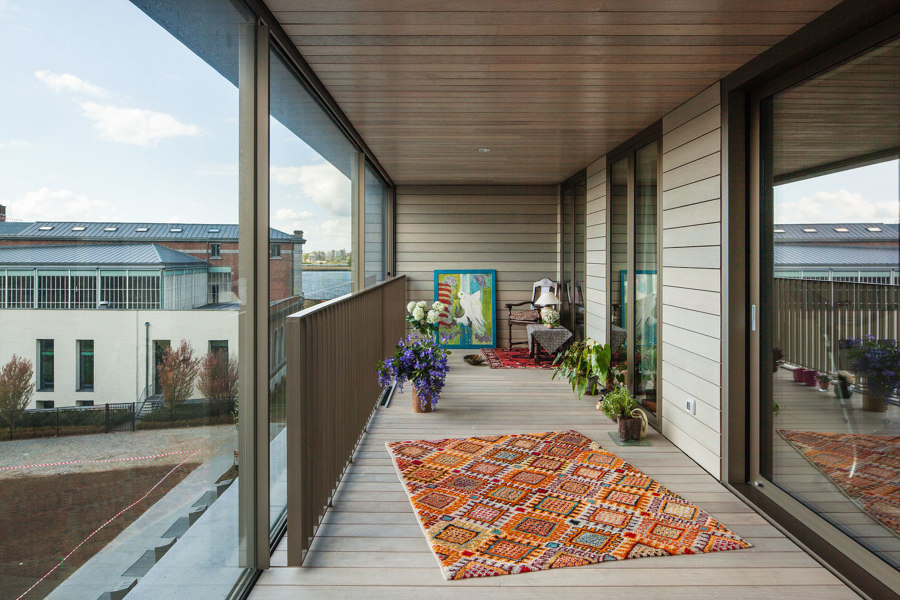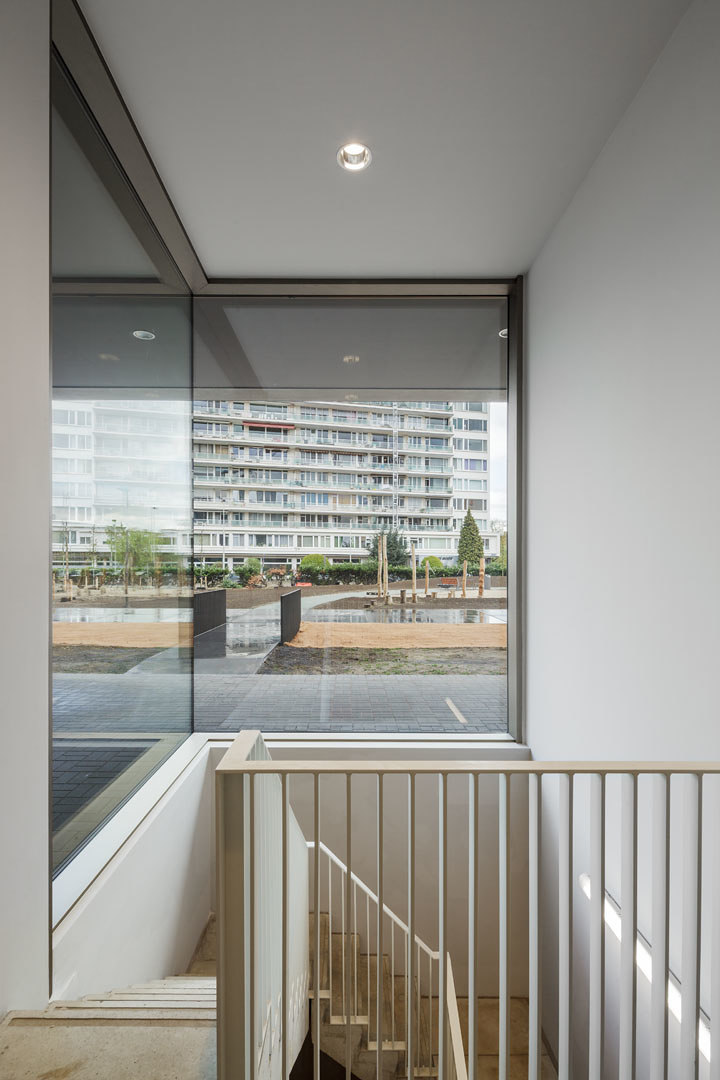Belgium is a country with a less strong link with modernism and rationalism in the 20th century compared to others in Europe. From the post – war period until recently primarily individual housing was stimulated for political reasons which created especially in Flanders a sheer endless suburb connecting quite a few of the big cities.
Still the city of Antwerp had always a tradition in the realisation for high quality small and medium scale apartment buildings especially in the 1930ties, 50ties and 60ties.
Since approximately 15 years also in Antwerp a strong and growing urban renaissance takes place, stimulated by personalities like former mayor Patrick Jansen and former city architect Kristiaan Borret. With enthusiasm and growing success the city faces the contemporary task of creating attractive answers on collective housing. There’s already a few good examples that could have been realized such as for instance from Diener & Diener or David Chipperfield.
Atelier Kempe Thill has already tried in several other competitions to develop a specific answer for a Flemish collective housing architecture. The commission for block 1 in Nieuw Zuid offers the unique opportunity to contribute to these fascinating current developments in Flanders in a substantial way.
Nieuw Zuid - a new city quarter
The new quarter of Antwerp Nieuw Zuid is the biggest urban extension not only for the city of Antwerp but even for Belgium in general. The area is located directly attached to the city centre in the South next to Richard Rogers’ famous palace of justice. On the territory of a former train station the city intends to build approximately 2000 apartments and 130.000m2 of other program with a high ambition of architectural and urban quality. The urban master plan has been conceived by the Italian office Secchi-Viganò in 2012 on the basis of so called “Striga’s”, an ancient Roman urban typology. The striga represents a medium sized urban block that is not closed but cut open to reach a balanced mixture of a modernist ensembles open space and a 19th century closed block city.
On the ground floor there are shops and public facilities, housing starts basically on the first floor. The buildings are a combination of approximately 6 storey slabs and high - rise towers. The entire development is going to be realized by Triple Living, a leading Belgian company.
The first block
The first building complex has very good spatial conditions with its relation to the river Scheldt and an adjacent park. POLO Architects from Antwerp that is asked to design this project invites Atelier Kempe Thill in autumn 2012 to design a part of the first block where in total 32 apartments with commercial spaces on the ground floor and a two floors underground parking fit in. The intention is a fast design and execution process with by the end of 2015 the first buildings to be delivered to the new inhabitants.
For Atelier Kempe Thill this is an ideal moment to finally get the occasion to develop a first housing project to be realized in Flanders. What kind of housing quality should be offered to the new middle class searching for an apartment? How should a high quality city extension look finally and how should the shops be integrated? What kind of materialisations should be chosen in an area with intensely used public spaces and the love of the Flemish for stone architecture?
Panoramic housing around a central core
To access the building two central cores are chosen that contain stairs and elevators. To position such access cores was at first glance rather difficult because it had to match the requirements of the parking garage as well as those of the ground floor with shops at the same time and the ambition of Atelier Kempe Thill to avoid access cores in the outside façade of the building. Also should they be positioned in a way that allows as good as possible to produce flexible floor plans for the apartments as well and allow a maximum differentiation in the sizes of the apartments, and all that finally in a depth of the actual building of 14 metres.
The basic partition allows a constellation of four apartments per floor accessed by one core. This constellation is varied in the south part. Here there are only three apartments, at the head façade there’s only one apartment profiting from three orientations.
Due to the asymmetric positioning of the core in relation to the width of the building the east side offers small studios, contrary to the west side where bigger, family oriented apartments are placed. The apartments can also be unified following the “kangaroo” – principle due to flexible separation walls between them.
On the top – floor there’s another variation by penthouses in a set – back. The final result is a more or less traditional system, neutral and modest but still astonishingly able to adapt on the needs of the 21st century on variation and flexibility.
Winter garden housing
The master plan of Secchi - Viganò has as one very inspiring aspect the idea that each building should offer large outside spaces on strategic positions of the building that can extend the actual building limits up to 3 metres. These “Bigger & Cheaper“ called outside spaces that are inspired by the concepts of the French architects Lacaton & Vassal can be set up as balconies but also be closed by glass doors to set them up as winter gardens and should add an unexpected quality to the apartments.
Atelier Kempe Thill takes this opportunity literal and occupies the east as well the west side of the building entirely with winter gardens. The winter gardens have an average length of 10 metres and a depth of 2,6 metres. That way a 123 m2 apartment has as additional space 60 m2 winter garden or a 40 m2 studio is combined with 30 m2 extra winter garden. The apartments can offer with such generous outside spaces a relaxed suburban life quality in an urban density.
The actually insulated part of the building is conceived according to passive house standards. This part can be seen as the winter part that is extended in its use by the winter garden as a seasonal buffer space. This way each house offers a summer and a winter part that is also inspired by traditional Japanese houses. City inhabitants can live during the warm season outside by opening the sliding doors, in the colder seasons with closed sliding doors they can still use the terraces because they are protected against wind and rain.
The winter gardens that entirely cover the insulated parts of the houses are also reacting on the catholic context in Belgium. Unless their fully glazed façades to the outside the winter gardens offer a buffer to give more privacy to the actually thermally insulated part of the house.
Concrete, wood and glass
Flemish culture is a very physical culture very much influenced by a Burgundian love for the pleasures of life and where one can still feel even in the cities a certain rural attitude. Solid brick is the typical basic materialization of buildings in Flanders as a nearly unavoidable circumstance being expressed in the common saying that “every Belgian is born with a brick in his stomach”.
Atelier Kempe Thill searched for an architectural expression that could create a dialogue between this more traditional view on things and a possible more modernist orientation towards the future at the same time. The slightly higher budget compared to more common circumstances allowed in the end a very solid materialization hard to find within the contemporary condition of European housing.
Technically the façade expression also has to solve the Belgian fire rules that consider winter gardens as inside spaces with the consequence that along the façade a distance of 1metre fire proof façade has to be respected between neighbours, horizontally as well as vertically.
For all these reasons the façades are set up in prefabricated concrete elements. Beams and columns have sections of 60 cm height x 40 cm depth to fulfil the distance of 1 metre for the fire department. The loadbearing beams along the east and west façades are up to 11,5m long and create winter gardens of an unusual length. This length assures that the relatively fat dimensions of the concrete elements are brought back into a harmonious proportion to their total size and add a refreshing monumental scale to the building as a total.
On the head façades large scale non – load bearing concrete elements of partly 5,6 metres x 3,2 metres create a special quality out of the fact that the percentage of glass in the insulating part of the façade is limited.
For Atelier Kempe Thill it is the first time to work with a façade entirely made out of prefabricated concrete elements. The concrete is chosen in anthracite colour and with a smooth and polished surface. Each element is custom – made. The dimensions of the elements even allowed to integrate rainwater pipes and at the very end of the execution foldable fire ladders into the columns that had been demanded all of a sudden by the fire department.
The concrete elements are combined with large single glass sliding doors for the winter gardens that on the fourth floor reach up to 3,2 metres by 3,5 metres per element.
To give the winter gardens a liveable and cosy atmosphere they are in the interior entirely covered by a wooden cladding. The “woodiness” of the terraces also contributes to the appearance at the outside giving the building a welcoming vibrancy balancing the formal monumentality of the concrete elements and the sliding doors.
With this concept and all its ingredients the project tries to offer a modern and light life style with at the same time an architectural answer to the more physical character of Belgian culture.
Design Team:
Atelier Kempe Thill: André Kempe, Oliver Thill, Laura Paschke with Martins Duselis, Andrius Raguotis and Teun van der Meulen
Urban planning: Studio Associato Bernardo Secchi Paola Viganò, Milan / IT
Landscape architect: Bureau Bas Smets, Brussel
Structural engineer: Studiebureau Forté bvba, Geel
Building physics/ EPB: CES nv, Asse



































